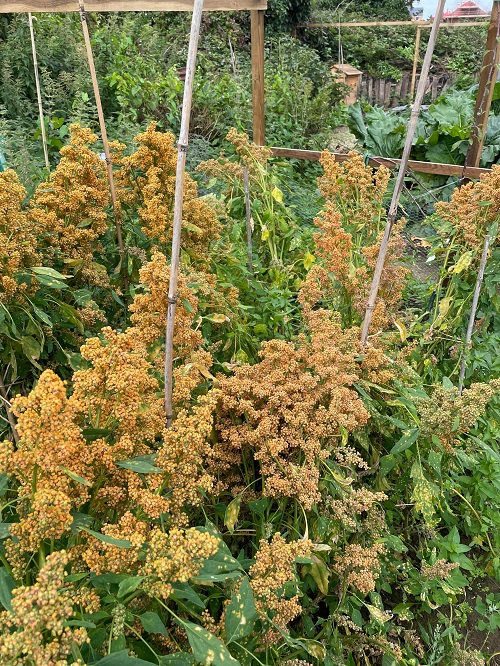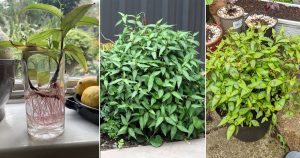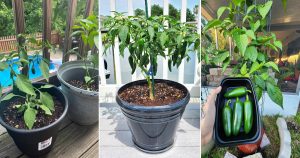Learn how to grow quinoa in this article. Growing quinoa needs to fulfill a few requirements which are given below.

Quinoa (Chenopodium quinoa) is an annual plant that is cultivated for grains. Grown for over 5000 years and was part of the staple diet of pre-Columbian civilizations. Today, it is consumed as an alternative to rice.
It is an edible plant acknowledged for its high nutritional value. Quinoa (KEEN-wah) has become popular in kitchens and restaurants over the past decade. It’s also gaining attention in gardens. This plant is easy to grow by planting seeds directly in the soil.
Quinoa produces large, fluffy seed heads filled with tiny seeds in red, white, brown, or black. These seeds are gluten-free, high in protein, and have a nutty, slightly sweet taste. You can also eat the young, tender leaves, which are nutritious and taste similar to spinach.
USDA Zones— 4 – 10
Difficulty— Easy to Moderate
Other Names— Chenopodium quinoa (Scientific Name), Quinua, Quinua, Kiuna Quinhua, Huauzontle, Huauthili and Nuttall’s goosefoot,
Propagation and Planting of Quinoa

Plant seeds 1 to 2 inches apart and about a quarter inch deep. Leave 12 to 24 inches between rows. The seeds sprout quickly, usually in 7 to 10 days. Once the seedlings appear, thin them out so each plant is 12 inches apart. This step is essential because proper spacing helps the plants grow bigger and produce more seed-bearing stems.
Requirements for Growing Quinoa
Position
Quinoa prefers a moderately cool climate and can survive light frost but not heavy freeze. It can not grow in areas where temperatures are usually above 95 F (35 C) or below 30 F (-1 C).
Choose an area of land that receives full sun, though it could withstand partial shade, with a consequent decrease in the harvest.
Soil
Soil preparation is very important for growing this grain. To cultivate quinoa, optimally use loamy, semi-deep, fertile soil with good drainage. It can also grow in more adverse soil types like sandy, clayey, and even moderately saline soil, but again, yield can be lower. It prefers a slightly acidic to slightly alkaline pH (6 to 8.5).
Watering
Quinoa is well adapted to dry conditions and has no problem with minimal water. Water plants only in case of extreme heat or prolonged drought. However, it needs regular watering during the flowering period.
Temperature and Humidity
Quinoa grows best in moderate temperatures and low humidity. Plant the seeds as soon as the soil is ready in spring to make sure the plants flower before the summer heat. Temperatures above 95°F can stop the flowers from maturing and producing seeds.
Quinoa Plant Care

Fertilizer
If you want, you can mix well-decomposed compost into the soil when planting quinoa to add nutrients. However, quinoa grows well in poor, infertile soil and usually doesn’t need extra fertilizer in most places.
Weeding
Quinoa may look very similar to weeds. It grows slowly at first and will be affected by weeds. Regular weeding should be done during this period, and mulch around the plant to suppress unwanted plants. Once it reaches about 30 cm in height, it begins to grow much faster and becomes self-sufficient.
Pests and diseases
If you are growing quinoa, you should know it is related to spinach and beetroot, and therefore, it is susceptible to similar diseases and pests. However, it generally remains pest-free but can be attacked by aphids, caterpillars, and beetles. Keep the plant healthy and treat it with organic pesticide immediately to deter away the pests. However, a mature plant can usually withstand any damage caused by these small insects without much difficulty.
Harvest and storage
Quinoa is ready to harvest when you can barely dent the seed coat with your fingernail. By this time, the plants are usually dry, and their leaves have fallen off. Depending on when you plant quinoa, it’s often ready to harvest in August or September, about 90-100 days after planting.
To harvest, hit the flower stalks against a hard surface or rub them between your hands to separate the seeds from the flower parts (called chaff). To clean the seeds, spread them on a cloth and use a fan to blow away the lighter chaff. You may need to pick out larger pieces by hand.
For long-term storage, keep quinoa in an airtight container in the fridge. You can also store it in a paper bag at room temperature for 3–6 months.
Before cooking, quinoa seeds must be rinsed to remove their soapy coating, which is called saponins. Soak and rinse the seeds in water several times until the water runs clear, or rinse them under hot running water multiple times.
You can also eat the young leaves of quinoa, like spinach, in salads. Harvest a few leaves from mature plants or grow quinoa just for its salad greens. Keep in mind that harvesting too many leaves from young plants can reduce the number of seeds they produce.










